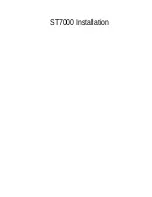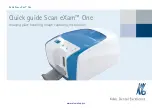
47
NOTA 1: A 80 MHz y 800 MHz, se aplica el rango de frecuencia más alto.
NOTA 2: Puede que estas pautas no se apliquen a todas las situaciones. La propagación electromagnética
se ve afectada por la absorción y refl exión de las estructuras, objetos y personas.
a Los campos de fuerza de trasmisores fi jos, como la estación base de radio, teléfonos (celulares/
inalámbricos) y radios móviles, radioafi cionados, transmisiones de radio AM y FM y transmisiones de
TV no se pueden predecir teoréticamente con exactitud. Para evaluar el ambiente electromagnético
debido a trasmisores RF fi jos debe de considerarse realizar una evaluación del lugar. Se debe de
observar el campo de fuerza del lugar en donde se va a utilizar el Oxímetro de pulso (18710) para
verifi car que opere normalmente. Si se observa una operación anormal se deben de tomar medidas
adicionales como reorientar o reubicar el Oximetro de pulso (18710).
b Sobre un rango de frecuencia 150 kHz a 80 MHz, los campos de fuerza deben ser menores a 3 V/m
Distancias de separación recomendadas entre equipo de comunicación RF portátil y móvil y el
EQUIPO o SISTEMAS - Para todo EQUIPO y SISTEMAS que no sean de SOPORTE VITAL
Distancias de separación recomendada entre
equipo de comunicación RF portátil y móvil y el Oxímetro de pulso (18710)
El Oxímetro de pulso (18710) está diseñado para ser usado en un ambiente electromagnético en donde
las alteraciones por RF radiado estén controladas. El cliente o usuario del Oxímetro de pulso (18710)
puede ayudar a prevenir la interferencia electromagnética al mantener la distancia mínima entre equipo de
comunicaciones RF portátil o móvil (transmisores) y el Oxímetro de pulso (18710) como se recomienda a
continuación, de acuerdo a la máxima energía de salida del equipo de comunicación.
Máxima energía de
salida del trasmisor (W)
Distancia de separación de acuerdo a la frecuencia del trasmisor (m)
a Field strengths from
xed transmitters, such as base station for radio (cellular/cordless) telephones and
land mobile radios, amateur radio, AM and FM radio broadcast and TV broadcast cannot be predicted t
heoretically with accuracy. To assess the electromagnetic environment due to
xed RF transmitters, an
electromagnetic site survey should be considered. If the measured
eld strength in the location in which
the Pulse Oximeter (18710) should be observed to verify normal operation. If abnormal performance is
observed, additional measurements may be necessary, such as reorienting of the relocating the Pulse
Oximeter (18710).
b Over the frequency range 150 kHz to 80 MHz,
elds strengths should be less than 3 V/m
Recommended separation distances between portable and mobile RF communications equipment
and the EQUIPMENT or SYSTEMS -For all EQUIPMENT and SYSTEMS that are not LIFE-SUPPORTING
Recommended separation distances between
portable and mobile RF communications equipment and Pulse Oximeter (18710)
The Pulse Oximeter (18710) is intended for use in electromagnetic environment in which radiated RF
disturbances are controlled. The customer or the user of the Pulse Oximeter (18710) can help prevent
electromagnetic interference by maintaining a minimum distance between portable and mobile RF
communications equipment (transmitters) and the Pulse Oximeter (18710) as recommended below,
according to the maximum output power of the communications equipment.
Rated maximum output
power of transmitter (W)
Separation distance according to frequency of transmitter (m)
0.01
0.1
1
10
100
0.1167
0.2334
0.7378
2.3334
7.3786
23.3334
0.3689
1.1667
3.6893
11.6667
80 MHz to 800 MHz
800 MHz to 2.5 GHz
d=
3.5
E
1
P
d=
7
E
1
P
- 13 -
0.01
0.1
1
10
100
80 MHz to 800 MHz
a Field strengths from
xed transmitters, such as base station for radio (cellular/cordless) telephones and
land mobile radios, amateur radio, AM and FM radio broadcast and TV broadcast cannot be predicted t
heoretically with accuracy. To assess the electromagnetic environment due to
xed RF transmitters, an
electromagnetic site survey should be considered. If the measured
eld strength in the location in which
the Pulse Oximeter (18710) should be observed to verify normal operation. If abnormal performance is
observed, additional measurements may be necessary, such as reorienting of the relocating the Pulse
Oximeter (18710).
b Over the frequency range 150 kHz to 80 MHz,
elds strengths should be less than 3 V/m
Recommended separation distances between portable and mobile RF communications equipment
and the EQUIPMENT or SYSTEMS -For all EQUIPMENT and SYSTEMS that are not LIFE-SUPPORTING
Recommended separation distances between
portable and mobile RF communications equipment and Pulse Oximeter (18710)
The Pulse Oximeter (18710) is intended for use in electromagnetic environment in which radiated RF
disturbances are controlled. The customer or the user of the Pulse Oximeter (18710) can help prevent
electromagnetic interference by maintaining a minimum distance between portable and mobile RF
communications equipment (transmitters) and the Pulse Oximeter (18710) as recommended below,
according to the maximum output power of the communications equipment.
Rated maximum output
power of transmitter (W)
Separation distance according to frequency of transmitter (m)
0.01
0.1
1
10
100
0.1167
0.2334
0.7378
2.3334
7.3786
23.3334
0.3689
1.1667
3.6893
11.6667
80 MHz to 800 MHz
800 MHz to 2.5 GHz
d=
3.5
E
1
P
d=
7
E
1
P
- 13 -
800 MHz to 2.5 GHz
0.1167
0.3689
1.1667
3.6893
11.6667
0.2334
0.7378
2.3334
7.3786
23.3334
Summary of Contents for Health Ox 18710
Page 2: ...English Drive Health Ox Fingertip Pulse Oximeter...
Page 18: ...18 Fran ais Drive Health Ox Oxym tre de pouls digital...
Page 34: ...34 Espa ol Drive Health Ox Ox metro de pulso para dedo...
Page 50: ...DRIVE MEDICAL DESIGN MANUFACTURING Phone 877 224 0946 Fax 516 998 4601 www drivemedical com...




































